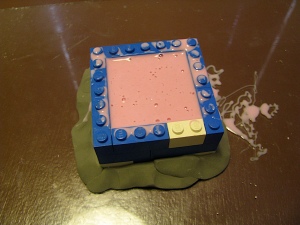This might not seem like such a big deal, but for some reason I had issues creating a 1″ square tile. I figure if I could find a way to make the “perfect” tile, I could then use it as a push mold for sculpey in order to create more detailed tiles down the road.
I found a surprisingly simple solution. First, I searched high and low for a 1″ square cookie cutter, but to no avail. I eventually stumbled across some old legos and discovered that you could lay them out in such a pattern that they form a near perfect 1″ interior square.

I then tried several different products to pour into the mold, and got the best results from using hydrostone mixed to the consistency of putty and pushed into the mold then scraped level with the top. Although these two pictures of the mold in use show me casting with resin.


Once I created a good standard tile, I made a mold of it using mold max 30 from smooth-on. This was only the fourth mold I’ve ever created. Mold max 30 is a two part mold making RTV, and thus far I’ve had great success with it. It has been incredibly easy to use. In order to create the mold, I took my favorite tile, glued it down to some glass (provided by an unused picture frame), and built a lego mold around it. For good measure I placed non-hardening clay around the edges to stop any seapage. I discovered the hard way while attempting to cast my first project that if you don’t glue smaller objects down they will float to the top of your mold making material. I know it seems pretty self explanatory, but we’re all allowed our mistakes… right? Here are some pics of the process.



There are two molds because I had mixed up too much mold max and had an extra tile laying around that I hadn’t been overly impressed with but I decided, “what the heck might as well use it, who knows I might be able to use it somewhere.”
And that’s how I created a mold for my first batch of 1″ square tiles. Stay tuned for more information on how I plan on using the mold. Thanks for reading.